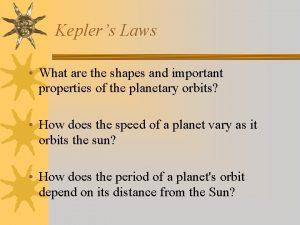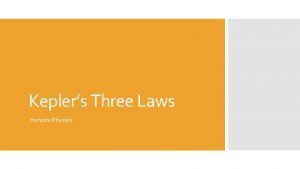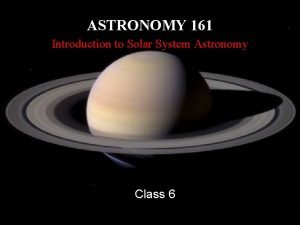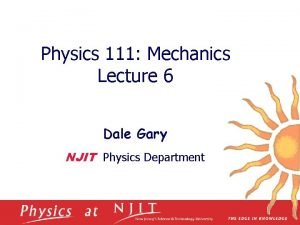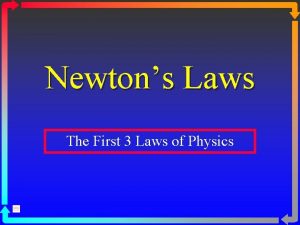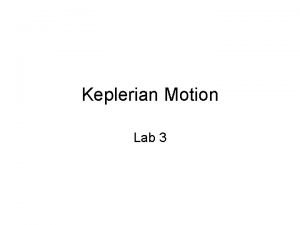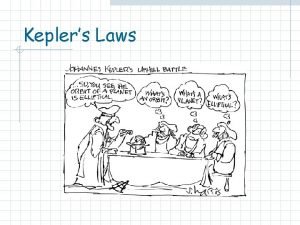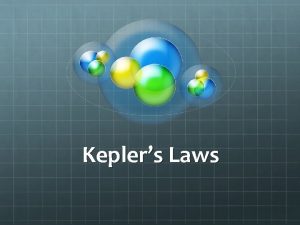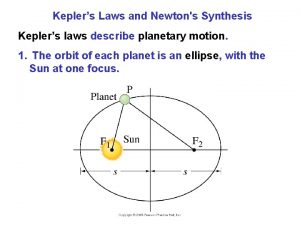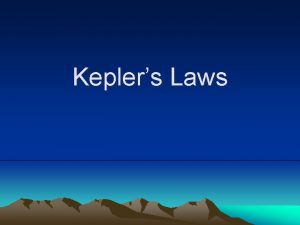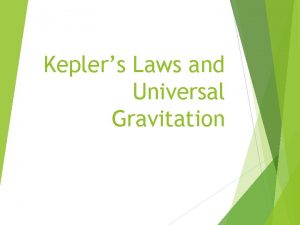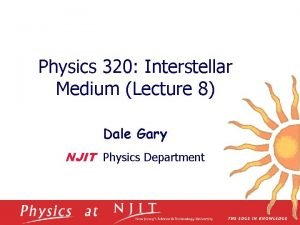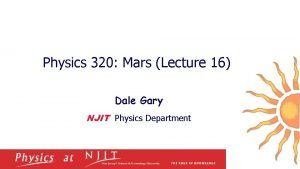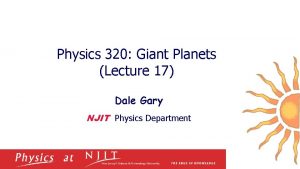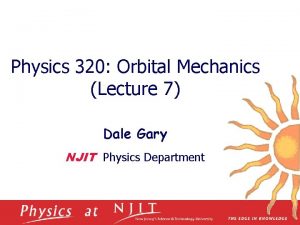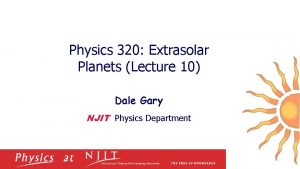Physics 320 Keplers Laws Lecture 3 Dale Gary













- Slides: 13

Physics 320: Kepler’s Laws (Lecture 3) Dale Gary NJIT Physics Department

q Support for the Heliocentric Model Although Copernicus set down the basic principles of the heliocentric model, it was regarded as simply an alternative way of thinking about the universe, without any certainty that the Earth really moved. Two later scientists, Galileo and Kepler, gave several strong arguments in favor of the heliocentric model. q Around 1610, Galileo gave observational evidence based on telescope views: n n Moons of Jupiter gave clear evidence of one object orbiting another Phases of Venus gave clear evidence that Venus circles the Sunspots on the Sun gave clear evidence that the heavens are not “perfect” Craters and mountains on the Moon gave clear evidence that the Moon is another world. Feb 28 Apr 9 Apr 20 May 4 May 8 May 16 May 22 September 11, 2018

Galileo’s Sunspot Drawings Galileo was making his first telescopic observations of the Sun during a sunspot maximum period. q His drawings show the rotation of the Sun, show it to be a sphere, and more importantly, show that its surface is not “perfect, ” as heavenly bodies were thought to be. q September 11, 2018

Galileo’s Moon Drawings Galileo was convinced that the light and dark regions are the Moon were mountains and valleys, and he watched their shadows grow as the illumination changed. q However, most people accepted that the Moon was circling the Earth, and that it had markings indicating an uneven surface. q September 11, 2018

Tycho and Kepler Tycho Brahe was the last great observer who did not use a telescope, in the decades just preceding Galileo. q He made extremely precise measurements of the positions of the planets over a long time, using large mechanical devices for precise measurement of angles. He wanted to prove his own model for the solar system, which was a strange mixture of Ptolemy’s and the Coperican system. But he lacked the mathematics to make the necessary reduction of the data, so he hired an assistant, Johannes Kepler. q Kepler disagreed with Tycho’s model, but did not complete his work until after Tycho died. q Kepler was a great mathematician, and after studying Tycho’s measurements over many years, he came up with his three laws of planetary motion (qualitative version): q First Law: Planets travel in elliptical orbits with the Sun at one focus Second Law: Planets move more slowly in their orbits when far from the Sun than when close to the Sun Third Law: Planets with larger orbits move more slowly than planets with smaller orbits. September 11, 2018

How Kepler Got His First Law q Let's look at how Kepler determined his first Law. First, he showed how to measure the relative distance to the inner planets (Mercury and Venus) by measuring their angle of greatest elongation, a: Animation showing the six greatest Greatest Elongations for Mercury in 2001 -2002 (from JPL Calendar) consecutive elongations of Mercury listed q Sep 18 - Mercury Greatest Eastern Elongation (26 Degrees) above. The position of Earth is q Oct 29 - Mercury At Its Greatest Western Elongation (18 Degrees) advanced the appropriate q Jan 12 - Mercury At Its Greatest Eastern Elongation (19 Degrees) number of degrees around its orbit for each date, then the q Feb 21 - Mercury at Greatest Western Elongation (27 Degrees) line to Mercury is drawn East or West of the Sun as needed. q May 04 - Mercury Greatest Eastern Elongation (20 Degrees) Mercury is on this ray, at the q Jun 21 - Mercury at Greatest Western Elongation (22 Degrees) point that the ray passes closest to the Sun. September 11, 2018

First Law for Outer Planets Determining distance of outer planet from Sun: Take two measurements of the elongation (angle from the Sun) of Mars, one sidereal period (687 days) apart. Earth is at location E' at the time of the first observation, goes once around its orbit and arrives back at location E (almost completing two orbits) after Mars has gone around once. The figure below shows the situation at a larger scale, with the angles labeled. The two elongation angles are e and e', and we also know the angle n, which is just the number of degrees less than two full orbits that the Earth makes in 687 days. You should be able to show that n = 42. 89 degrees. Since triangle DSEE' is isoceles, we can determine a, (you should be able to show that it is 68. 56 degrees) qand hence the length EE' (use the Law of Sines to show Kepler repeated this procedure for many pairs of measurements of the planet that it is 0. 73 AU). Subtract a from e and e', which Mars, taken by the excellent observer, Tycho Brahe, and was able to show that allows us to solve for triangle DEPE'. Finally, using the Law the distance of Cosines for triangle DSPE', we can determine r varies with time in the way expected if the path were an ellipse! the distance r. You can see that this is not easy, and requires extremely good observations of angles. September 11, 2018

Properties of Ellipses Properties of the Ellipse: • • Semi-major axis a = half of the long axis of ellipse Semi-minor axis b = half of the short axis of ellipse Eccentricity e = distance of focus F from center, in units of a. The eccentricity ranges from 0 (a circle) to 1 (a parabola). Sum of distances of a point on the ellipse from the two foci (a and r') is a constant: r + r'=2 a. The triangle at right is 1/2 of the triangle formed by the light gray lines in the figure above. Convince yourself that the lengths of the sides are as shown. By the Pythagorean Theorem, show that the following relation holds: b 2 = a 2(1 -e 2). September 11, 2018

Equation for an ellipse q We would like to have an equation for the ellipse, and it is most convenient to express it in polar coordinates, relative to an origin at the focus F. A point on the ellipse P(r, q) will then have polar coordinates r and q, as shown in the diagram below. In the case of planetary orbits q is called the trueanomaly. September 11, 2018

Orbits as Ellipses q September 11, 2018

Conic Sections q Although Kepler showed that planets orbit in ellipses, more generally we know that objects orbit in one of three “conic sections, ” ellipse, parabola, and hyperbola, where: q Ellipse: q Parabola q Hyperbola A circle is a special case of an ellipse, with e = 0 September 11, 2018

Kepler’s Laws (Quantitative) Kepler's Three Laws (quantitative version) First Law: Second Law: The radius vector of a planet sweeps out equal areas in equal times (planet travels fastest when near perihelion). Third Law: September 11, 2018

What We’ve Learned q q q Know the names Tycho Brahe and Johannes Kepler, and what they did. Know that the careful measurements by Tycho Brahe were used by Kepler to quantitatively measure and characterize the orbits of the planets, and prove the heliocentric model in which the planets move around the Sun. Know the important terms for ellipses, such as focus, semi-major and semiminor axis, eccentricity, and the terms for orbits of perihelion and aphelion, and generally know how they are related. Know that eccentricity e = 0 gives a circle, 0 < e < 1 gives an ellipse, e = 1 gives a parabola, and e > 1 gives a hyperbola. Be familiar with (no need to memorize) the equations for the conic sections. Be able to state and describe Kepler’s three laws. We will be using the third law extensively! September 11, 2018
 Kepler law
Kepler law Keplers three laws
Keplers three laws Keplers phase funnel
Keplers phase funnel Kepler's laws
Kepler's laws Dale gary
Dale gary 01:640:244 lecture notes - lecture 15: plat, idah, farad
01:640:244 lecture notes - lecture 15: plat, idah, farad Useless laws weaken the necessary laws
Useless laws weaken the necessary laws Classical mechanics
Classical mechanics Physics 101 lecture
Physics 101 lecture Physics 101 lecture 1
Physics 101 lecture 1 Physics 101 lecture notes pdf
Physics 101 lecture notes pdf Physics waves notes pdf
Physics waves notes pdf Atmospheric physics lecture notes
Atmospheric physics lecture notes ßwe
ßwe
